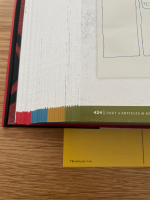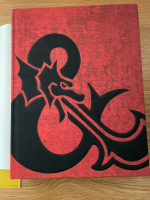This nearly 600-page book is no mere tome, it's an artifact.

Books like Slaying the Dragon: The Secret History of Dungeons & Dragons and Game Wizards: The Epic Battle for Dungeons & Dragons, the latter written by Jon Peterson, who is credited here for “curation and commentary,” have already detailed the history of the game. What TMoODnD does differently is show you documentation of the game being developed, reprinting notes, letters between Dave Arneson and Gary Gygax, character sheets, iterations of character classes through development, zine articles and so much more. In fact, pages 84-182 even reprint the very first iteration of D&D. Then pages 202-329 reprint the first boxed set.
So this isn't the normal “history of D&D” book. While there is a narrative to how it all came together that's almost secondary to showcasing page after of page rare and hard-to-find material. Basically, that means this book will be of interest to certain type of fan instead of the broader base that might be interested in the interpersonal and legal disputes documented by the other books I mentioned.

Because the materials reprinted are so old, haven't been kept in pristine conditions, and weren't created with the intention to last for decades, some of the reprints are easier to read than others. It's definitely a peek at zine production before personal computers were common, let alone today's sophisticated illustration and layout software. A little cleanup was done to improve readability, but otherwise the notes, zines, etc. are presented as is.

As already noted, Part 2 is the 1973 draft of D&D, and Part 3 looks at how the rules were expanded, comparing the draft version versus the published Original Dungeons & Dragons, the Brown Box and White Box. The last section is about “Articles & Additions,” such as early Greyhawk, Blackmoor, Eldritch Wizardry, and The Dragon, among others.
TMoODnD itself is beautifully designed. Under the red and gold dust jacket the hardcover is embossed red and black of the ampersand. Its four sections are noted by four satin ribbons sewn in, color coded to their sections. Unfortunately, because it is so big, it's also unwieldy to hold and photograph its interior pages, let alone do so without possibly hurting the spine since it's managing such weight.
TMoODnD is also only available as a hardcover. Not having an audiobook version makes some sense because the interest is in seeing the reprinted notes and documents. Maybe an ebook version will be released later, but I doubt it.

A Historical Artifact
While many may compare The Making of Original Dungeons & Dragons: 1970-1977 to a tome – and at 576 pages that's not an inaccurate description – a more accurate assessment would be to compare it to an artifact.Books like Slaying the Dragon: The Secret History of Dungeons & Dragons and Game Wizards: The Epic Battle for Dungeons & Dragons, the latter written by Jon Peterson, who is credited here for “curation and commentary,” have already detailed the history of the game. What TMoODnD does differently is show you documentation of the game being developed, reprinting notes, letters between Dave Arneson and Gary Gygax, character sheets, iterations of character classes through development, zine articles and so much more. In fact, pages 84-182 even reprint the very first iteration of D&D. Then pages 202-329 reprint the first boxed set.
So this isn't the normal “history of D&D” book. While there is a narrative to how it all came together that's almost secondary to showcasing page after of page rare and hard-to-find material. Basically, that means this book will be of interest to certain type of fan instead of the broader base that might be interested in the interpersonal and legal disputes documented by the other books I mentioned.
How Reprints are Handled
The reprints are handled with specific rules to balance accuracy with discretion. For example, the only things redacted from the documents are street addresses and phone number. Everything else is reprinted unaltered from original documents. In some cases, that includes off-color language and even insults, such as some disparaging comments about the women's liberation movement of the 1970s. None of that is changed or omitted, though historic context is provided.Because the materials reprinted are so old, haven't been kept in pristine conditions, and weren't created with the intention to last for decades, some of the reprints are easier to read than others. It's definitely a peek at zine production before personal computers were common, let alone today's sophisticated illustration and layout software. A little cleanup was done to improve readability, but otherwise the notes, zines, etc. are presented as is.
Layout
This humongous book, which could double as an improvised weapon in a D&D campaign, is broken into four sections. The first focuses on precursors to D&D, such as David Wesely's Braunstein campaign, which was Arneson and Gygax's first exposure to the concept of one player acting as a single character in a game, unlike typical wargames where a player controlled entire units or armies. From that concept, the role-playing game industry sprang.As already noted, Part 2 is the 1973 draft of D&D, and Part 3 looks at how the rules were expanded, comparing the draft version versus the published Original Dungeons & Dragons, the Brown Box and White Box. The last section is about “Articles & Additions,” such as early Greyhawk, Blackmoor, Eldritch Wizardry, and The Dragon, among others.
TMoODnD itself is beautifully designed. Under the red and gold dust jacket the hardcover is embossed red and black of the ampersand. Its four sections are noted by four satin ribbons sewn in, color coded to their sections. Unfortunately, because it is so big, it's also unwieldy to hold and photograph its interior pages, let alone do so without possibly hurting the spine since it's managing such weight.
TMoODnD is also only available as a hardcover. Not having an audiobook version makes some sense because the interest is in seeing the reprinted notes and documents. Maybe an ebook version will be released later, but I doubt it.



